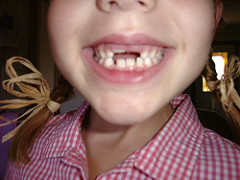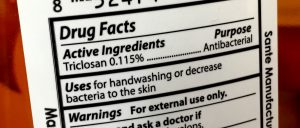What Can I Do About My Sensitive Teeth? Your Dentist Has Answers!
May 22, 2018
 It’s a mild spring day and you’re out with your family enjoying a delicious serving of ice cream, when all of a sudden, you feel a twinge of discomfort in your front teeth from your cold dessert. You wonder, “Why did this happen – Do I have to avoid ice cream from now on?” Your local dentist says that there are ways to address your sensitive teeth, so that you can once again enjoy life. Learn about them as you read on!
It’s a mild spring day and you’re out with your family enjoying a delicious serving of ice cream, when all of a sudden, you feel a twinge of discomfort in your front teeth from your cold dessert. You wonder, “Why did this happen – Do I have to avoid ice cream from now on?” Your local dentist says that there are ways to address your sensitive teeth, so that you can once again enjoy life. Learn about them as you read on!
INTERESTING STUDY
May 21, 2018
 A Harvard-led study published in the journal, Science Translational Medicine, has determined that the use of low-powered lasers can stimulate stem cells enough to regenerate and grow rat teeth and human dental tissue. This concept may seem barbaric, but it could be a metamorphic tool in the constantly evolving world of dentistry.
A Harvard-led study published in the journal, Science Translational Medicine, has determined that the use of low-powered lasers can stimulate stem cells enough to regenerate and grow rat teeth and human dental tissue. This concept may seem barbaric, but it could be a metamorphic tool in the constantly evolving world of dentistry.
Researchers have been trying to figure out new ways to use the versatility of stem cells since they exist in abundance throughout the human body. Stem cells are unique in the sense that they can become different types of cells, making them prime candidates to repair or replace damaged tissue.
Although the research is still in its earliest stages and has yet to be tested on humans, using lasers to stimulate growth is not a new concept – but this study marks the first time that this process has been demonstrated and observed. The findings in this study could potentially change the future of dentistry since it could be possible to regrow teeth rather than replacing them with another material.
The experiment involved drilling holes in rat molars to expose the dentin (the layer of tooth under enamel); one molar was treated with a laser while the other molars went untreated. After 12 weeks, the researchers noticed that the dentin was growing back in the treated molar. After this finding, all of the rat molars were treated with lasers and yielded the same results.
This technique was also tested on various mammal cells and the researchers observed that certain oxygen-containing molecules were stimulated and caused the stem cells to convert into dentin as well. When this technique was tested on human dental stem cells, the results were also similar.
Although this is groundbreaking research, don’t expect to see this technique offered by your dentist to fix your cavities or replace your missing teeth any time soon. Even though the teeth grew back in the rats, the teeth did not grow back perfectly each time. Early studies like these are exciting but take years to even determine how they will apply to clinical practice in humans.
There is a light at the end of the tunnel. Since human teeth are larger than rat teeth, researchers hypothesize that it could be possible to pinpoint certain growth areas without causing the problems they have seen in the formation of the tooth material in rats. The researchers are currently developing human trials for this technique to see what the laser and stem cell combination have in store for the future of dentistry.
The best dentistry is always not to need any dentistry. Regular maintenance appointments with your favorite dental office are the best way to keep on top of that. Although there is cool research going on for the prevention and solution of common dental problems, most dental problems are completely avoidable with proper care.
TRICLOSAN
May 14, 2018
 One of my great patients, Malcolm, recently sent me an article he received from his Alma Mater entitled “Risky Bristles”. Malcom wanted me to share some information with you about triclosan.
One of my great patients, Malcolm, recently sent me an article he received from his Alma Mater entitled “Risky Bristles”. Malcom wanted me to share some information with you about triclosan.
According to the Environmental Protection Agency, triclosan is an antimicrobial agent that helps to “slow or stop the growth of bacteria, fungi, and mildew.” It first started to appear in antibacterial hand soap products in the 1970’s.
Since then, according to the Center for Disease Control, “it has been used in consumer products such as detergents, soaps, skin cleansers, deodorants, lotions, creams, toothpastes, and dishwashing liquids.” Many products labeled as “antibacterial” may contain triclosan or related compounds.
One of those products that contains triclosan is Colgate Total toothpaste. The reason the triclosan is in the toothpaste is to fight gingivitis, a common disease that causes inflammation and bleeding gums. Last year, an independent review of triclosan in toothpaste concluded that the chemical “reduced plaque, gingival inflammation, and gingival bleeding” but that those reductions “may or may not be clinically important.”
So, what’s the problem? While long-term research is lacking in humans, several studies of the effects of triclosan in mice and rats have found adverse health effects at high concentrations. Included in these findings were reduced fertility and increased cancer risk. It is important to note that chemicals can affect animals differently from humans. Animal testing can involve much higher concentrations of tested chemicals than humans would ever be exposed to. However, these kinds of findings in animals definitely raise eyebrows as to whether chemicals like triclosan are safe for human use.
According to the Center for Disease Control, “the human health effects from exposure to low environmental levels of triclosan are unknown. More research is needed to assess the human effects of exposure to triclosan.”
In December 2017, the FDA issued a final rule regarding certain OTC health-care antiseptic products. As a result, companies will not be able to use triclosan or 23 other active ingredients in these products without premarket review due to insufficient data regarding their safety and effectiveness. However, in 1997, the FDA reviewed extensive effectiveness data on triclosan in Colgate Total toothpaste. The evidence showed that triclosan in that product was effective in preventing gingivitis, so I believe this is still present in this toothpaste.
Triclosan has been phased-out of many soap products because of mounting evidence that these products don’t provide any health benefits above regular soap and water.
Certain environmental groups raised concerns over a decade ago that triclosan in soaps might be contributing to the rise in antibiotic resistant bacteria, which can cause dangerous infections that are hard to treat. These groups are also concerned that because the chemical gets washed down the drain, it may disrupt algae and wildlife found in water ecosystems.
So, should you throw away your toothpaste if it contains triclosan? That is up to you. My opinion is that there are plenty of other products and methods, without the inclusion of triclosan, that reduce the risk of gingivitis. Proper home care with any toothpaste in addition to regular dental visits, are sufficient to control gingivitis in most people.
Dr. St. Clair maintains a private dental practice in Rowley and Newburyport dedicated to health-centered family dentistry. If there are certain topics you would like to see written about or questions you have please email them to him at jpstclair@stclairdmd.com. You can view all previously written columns at www.jpeterstclairdentistry.com/blog.
REPLACEMENT PARTS
May 7, 2018
 It seems I have more and more patients telling me about their upcoming shoulder, hip, and knee replacement surgery. There are other parts that people have replaced, but those are the top three. Most of these people decide to go under the knife to improve their quality of life.
It seems I have more and more patients telling me about their upcoming shoulder, hip, and knee replacement surgery. There are other parts that people have replaced, but those are the top three. Most of these people decide to go under the knife to improve their quality of life.
If you were born in the Paleolithic era, you could expect to live to 33 years old. The average global life expectancy in 2010 was more than double this number at 67 years. The main reasons for this are advances in hygiene, food production, and medical care.
On the bright side, if you were born in the Paleolithic era, you would most likely never need a hip replacement. It usually takes longer than 33 years to wear out the joint.
Today, about 2.3% of Americans have had a hip replaced and 4.6% have had a knee replaced. More than a million joint replacements will be done this year and the number continues to grow. The longer we live, the more chance we have of parts needing replacement.
What about teeth? Your lower first permanent molars erupted into your mouth around the age of 6 years old. If you are 50 years old, these teeth have been tolerating chewing, hot coffee, cold ice cream, the occasional popcorn kernel, and maybe even grinding back and forth for 44 years. You have used them every day for 44 years!
What else can you use that much for 44 years that doesn’t require some kind of maintenance? How about that car you drive every day? The car certainly requires maintenance to function properly. The oil needs to be changed on a regular basis. Depending on several factors, the tires need to be rotated to wear evenly and usually need to be replaced after so many miles. I don’t know too many people who drive the same car for 44 years.
Of course, I am not insinuating that everyone needs replacement teeth at some point. I am saying that it is naïve to think that a car, a furnace, a computer or your teeth will run forever without maintenance, and that they will run better with routine maintenance.
What happens if you don’t do regular maintenance on your car? It will run for a long time, at some point its performance will decrease, and then when it finally decides to quit, it will be catastrophic. You will have to replace your car. How much will it cost to replace your car? Doesn’t it make sense to keep up with the routine maintenance?
Sometimes, even with regular maintenance, parts need to be repaired or replaced. We often have to make a decision on “how” to fix something. Do we patch it up to get some more miles out of it or do we replace the part to extend the serviceability? It may depend on the cost. It may also depend on the risk of the patch failing. You may decide that the risk is too high and go ahead and replace the part, even though it may cost more.
If you were a caveman, we wouldn’t be discussing this. You wouldn’t have a car and most of your own “parts” would make it to your expected 33 years. You are not a caveman. You are likely to wear parts out. You may need a hip replacement, or a filling, or a crown.
And remember: Regular oil changes and maintenance will help your car run well much longer.
WHAT DOES IT TAKE?
May 3, 2018
 Last year I wrote a column about a study I saw in an article from over a decade ago. It was about the poor odds people have making changes in their life actually happen. The article was an outpouring of concern from healthcare experts and doctors, all looking for a way to change the behavior of people who love their lifestyle so much that they were willing to literally die from it.
Last year I wrote a column about a study I saw in an article from over a decade ago. It was about the poor odds people have making changes in their life actually happen. The article was an outpouring of concern from healthcare experts and doctors, all looking for a way to change the behavior of people who love their lifestyle so much that they were willing to literally die from it.
In the Johns Hopkins study, 9 of 10 heart surgery patients chose to return to their unhealthy lifestyle, rather than make the changes needed to live longer. Very few were convinced by their doctors to make radical daily changes.
Based on my own experiences trying to move individuals to change habits that are having negative effects on their oral health, I knew it was difficult, but was shocked by the 90% statistic, especially relating to a do or die scenario. There are two studies that I have seen relating specifically to dentistry which confirm that changing behavior is not easy.
The first study looked at whether dental hygienists were as effective as they thought they were with oral hygiene instructions. The role of the dental hygienist is to instill the need, desire and ability for patients to achieve optimum oral health. The purpose of this study was to determine if patients correctly understood oral hygiene instructions provided by the hygienist and to see if the hygienists felt they were giving patients individualized instructions.
No big surprise, the findings showed a disconnect between what the hygienists believed they were conveying to their patients, and what the patients actually hear. So, part of the problem with getting people to change starts with actually confirming that the person understands the call to action and the implications of not acting.
The second study was to determine if a simple follow-up contact with the patient would impact behavioral change. In this study, patients had a routine dental hygiene appointment and were given specific oral hygiene recommendations based on their individual needs. Contact was then made with patients one week after their appointment.
The patients were asked if they tried the specifically recommended products they had been instructed to use, if they liked using them, and why or why not. Only 50 percent of the patients replied to the call-out from their hygienist. Of those who did respond, most said they tried the specifically recommended product, but only 33 percent of them felt they would continue to use it. The conclusion of the study was that follow-up contact alone is not an effective method to change behavior and does not increase compliance with oral health recommendations.
So, what does it take to get people to change their habits? I think it is safe to say that some will and some won’t, no matter the consequences.
Dr. St. Clair maintains a private dental practice in Rowley and Newburyport dedicated to health-centered family dentistry. If there are certain topics you would like to see written about or questions you have please email them to him at jpstclair@stclairdmd.com. You can view all previously written columns at www.jpeterstclairdentistry.com/blog.







